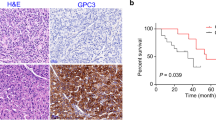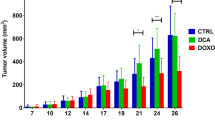Abstract
Purpose
There is currently no effective noninvasive method for accurate molecular typing of triple negative breast cancer (TNBC) except needle biopsy. Glucoregulated Protein 78 (GRP78) is overexpressed in TNBC cells and tumors which closely related to the invasion, metastasis, and drug resistance of cancer. Meanwhile, it has been verified that VAP peptide bind specifically to GRP78 in vitro and in vivo. In this study, we constructed a GRP78-targeted molecular probe Ga-68-radiolabeled DOTA-VAP conjugate ([68Ga]DOTA-VAP) based on VAP peptide, and evaluated its potential to distinguish TNBC from non-TNBC tumors.
Procedures
DOTA-VAP was synthesized and then radiolabeled with Ga-68 to obtain [68Ga]DOTA-VAP. The expression of GRP78 in TNBC MDA-MB-231 and non-TNBC MCF-7 cells was validated by Western Blot, and cell binding or uptake experiments with both [68Ga]DOTA-VAP and 2-deoxy-2-[18F]fluoro-D-glucose ([18F]FDG) were also performed. Biodistribution analysis and positron emission tomography (PET) imaging of [68Ga]DOTA-VAP were carried out in subcutaneous MDA-MB-231 and MCF-7 human breast cancer tumor models with [18F]FDG PET imaging as comparison.
Results
[68Ga]DOTA-VAP was prepared with high radiochemical purity which showed excellent stability in vitro. The MDA-MB-231 tumors were clearly visualized by [68Ga]DOTA-VAP PET imaging with a low background, except for the relatively high liver uptake. Cells and tumors of MDA-MB-231 could be distinguished from MCF-7 by [68Ga]DOTA-VAP instead of [18F]FDG. Biodistribution results were consistent with the imaging results. The blocking study with excess cold peptide showed significantly reduced tumor uptake, which indicated the specificity of [68Ga]DOTA-VAP targeting MDA-MB-231 tumors in vivo.
Conclusions
GRP78-targeted PET imaging with [68Ga]DOTA-VAP provided an effective approach for the noninvasive accurate classification of TNBC from other breast cancer subtypes comparing with [18F]FDG. GRP78 may be a potential target for the diagnosis and treatment of TNBC. For clinical transformation, efforts should be made to overcome deficiencies of [68Ga]DOTA-VAP such as relative high uptake in normal tissues.




Similar content being viewed by others
References
Denkert C, Liedtke C, Tutt A, von Minckwitz G (2017) Molecular alterations in triple-negative breast cancer-the road to new treatment strategies. Lancet 389:2430–2442
Bianchini G, Balko JM, Mayer IA, Sanders ME, Gianni L (2016) Triple-negative breast cancer: challenges and opportunities of a heterogeneous disease. Nat Rev Clin Oncol 13:674–690
Groheux D, Biard L, Giacchetti S, Teixeira L, Hindie E, Cuvier C, Vercellino L, Merlet P, de Roquancourt A, de Cremoux P, Resche-Rigon M, Espie M (2016) 18F-FDG PET/CT for the early evaluation of response to neoadjuvant treatment in triple-negative breast cancer: influence of the chemotherapy regimen. J Nucl Med 57:536–543
Kitajima K, Fukushima K, Miyoshi Y, Nishimukai A, Hirota S, Igarashi Y, Katsuura T, Maruyama K, Hirota S (2015) Association between 18F-FDG uptake and molecular subtype of breast cancer. Eur J Nucl Med Mol Imaging 42:1371–1377
Liu H, Chen Y, Wu S, Song F, Zhang H, Tian M (2016) Molecular imaging using PET and SPECT for identification of breast cancer subtypes. Nucl Med Commun 37:1116–1124
Ni M, Zhang Y, Lee AS (2011) Beyond the endoplasmic reticulum: atypical GRP78 in cell viability, signalling and therapeutic targeting. Biochem J 434:181–188
Bailly C, Waring MJ (2019) Pharmacological effectors of GRP78 chaperone in cancers. Biochem Pharmacol 163:269–278
Bartkowiak K, Kwiatkowski M, Buck F, Gorges TM, Nilse L, Assmann V, Andreas A, Muller V, Wikman H, Riethdorf S, Schluter H, Pantel K (2015) Disseminated tumor cells persist in the bone marrow of breast cancer patients through sustained activation of the unfolded protein response. Cancer Res 75:5367–5377
Cook KL, Soto-Pantoja DR, Clarke PA et al (2016) Endoplasmic reticulum stress protein GRP78 modulates lipid metabolism to control drug sensitivity and antitumor immunity in breast cancer. Cancer Res 76:5657–5670
Moriya C, Taniguchi H, Nagatoishi S et al (2018) PRDM14 directly interacts with heat shock proteins HSP90alpha and glucose-regulated protein 78. Cancer Sci 109:373–383
Serrano-Negron JE, Zhang Z, Rivera-Ruiz AP et al (2018) Tunicamycin-induced ER stress in breast cancer cells neither expresses GRP78 on the surface nor secretes it into the media. Glycobiology 28:61–68
Ghosh S, Adhikary A, Chakraborty S, Bhattacharjee P, Mazumder M, Putatunda S, Gorain M, Chakraborty A, Kundu GC, Das T, Sen PC (2015) Cross-talk between endoplasmic reticulum (ER) stress and the MEK/ERK pathway potentiates apoptosis in human triple negative breast carcinoma cells: role of a dihydropyrimidone, nifetepimine. J Biol Chem 290:3936–3949
Miao YR, Eckhardt BL, Cao Y, Pasqualini R, Argani P, Arap W, Ramsay RG, Anderson RL (2013) Inhibition of established micrometastases by targeted drug delivery via cell surface-associated GRP78. Clin Cancer Res 19:2107–2116
Lee E, Nichols P, Groshen S, Spicer D, Lee AS (2011) GRP78 as potential predictor for breast cancer response to adjuvant taxane therapy. Int J Cancer 128:726–731
Mandelin J, Cardo-Vila M, Driessen WH et al (2015) Selection and identification of ligand peptides targeting a model of castrate-resistant osteogenic prostate cancer and their receptors. Proc Natl Acad Sci U S A 112:3776–3781
Wang W, Zhao J, Wen X et al (2017) MicroPET/CT imaging of AXL downregulation by HSP90 inhibition in triple-negative breast cancer. Contrast Media Mol Imaging 2017:1686525
You L, Wang X, Guo Z, Zhang D, Zhang P, Li J, Su X, Pan W, Zhang X (2018) MicroSPECT imaging of triple negative breast cancer cell tumor xenografted in athymic mice with radioiodinated anti-ICAM-1 monoclonal antibody. Appl Radiat Isot 139:20–25
Henry KE, Dilling TR, Abdel-Atti D, Edwards KJ, Evans MJ, Lewis JS (2018) Noninvasive 89Zr-transferrin PET shows improved tumor targeting compared with 18F-FDG PET in MYC-overexpressing human triple-negative breast cancer. J Nucl Med 59:51–57
Montemagno C, Bacot S, Ahmadi M, Kerfelec B, Baty D, Debiossat M, Soubies A, Perret P, Riou L, Fagret D, Broisat A, Ghezzi C (2018) Preclinical evaluation of mesothelin-specific ligands for SPECT imaging of triple-negative breast cancer. J Nucl Med 59:1056–1062
Kapoor V, Dadey DY, Nguyen K et al (2016) Tumor-specific binding of radiolabeled PEGylated GIRLRG peptide: a novel agent for targeting cancers. J Nucl Med 57:1991–1997
Wang SH, Lee AC, Chen IJ et al (2016) Structure-based optimization of GRP78-binding peptides that enhances efficacy in cancer imaging and therapy. Biomaterials 94:31–44
Ferrara F, Staquicini DI, Driessen WHP et al (2016) Targeted molecular-genetic imaging and ligand-directed therapy in aggressive variant prostate cancer. Proc Natl Acad Sci U S A 113:12786–12791
Ran D, Mao J, Shen Q, Xie C, Zhan C, Wang R, Lu W (2017) GRP78 enabled micelle-based glioma targeted drug delivery. J Control Release 255:120–131
Wang SH, Yu J (2016) Data for peptide-binding assay with oriented immobilization of GRP78 in Biacore. Data Brief 7:1696–1699
Guleria M, Das T, Amirdhanayagam J et al (2018) Comparative evaluation of using NOTA and DOTA derivatives as bifunctional chelating agents in the preparation of 68Ga-labeled porphyrin: impact on pharmacokinetics and tumor uptake in a mouse model. Cancer Biother Radiopharm 33:8–16
Ray Banerjee S, Chen Z, Pullambhatla M, Lisok A, Chen J, Mease RC, Pomper MG (2016) Preclinical comparative study of 68Ga-labeled DOTA, NOTA, and HBED-CC chelated radiotracers for targeting PSMA. Bioconjug Chem 27:1447–1455
Poschenrieder A, Schottelius M, Schwaiger M, Wester HJ (2016) Preclinical evaluation of [68Ga]NOTA-pentixafor for PET imaging of CXCR4 expression in vivo - a comparison to [68Ga]pentixafor. EJNMMI Res 6:70
Acknowledgments
We wish to thank Dr. Yijun Zhu from Changzhou Siyao Pharmaceuticals Co. Ltd. for his support in chemical synthesis.
Author information
Authors and Affiliations
Corresponding author
Ethics declarations
Conflict of Interest
The authors declare that they have no conflict of interest.
Additional information
Publisher’s Note
Springer Nature remains neutral with regard to jurisdictional claims in published maps and institutional affiliations.
Rights and permissions
About this article
Cite this article
Zhao, H., Meng, H., Wen, J. et al. Noninvasive Classification of Human Triple Negative Breast Cancer by PET Imaging with GRP78-Targeted Molecular Probe [68Ga]DOTA-VAP. Mol Imaging Biol 22, 772–779 (2020). https://doi.org/10.1007/s11307-019-01416-4
Published:
Issue Date:
DOI: https://doi.org/10.1007/s11307-019-01416-4




